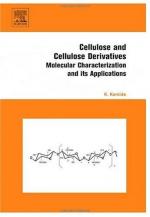|
This section contains 934 words (approx. 4 pages at 300 words per page) |

|
Overview
Cellulose (SELL-you-lohs) is a colorless to white, tasteless, odorless, polysaccharide fiber found in the cell walls of all land plants and some bacteria, seaweeds, algae, and fungi. Polysaccharides (the term means "many sugars") are polymers consisting of monosaccharide (simple sugar) monomers joined together in very large molecules. The monomer of which cellulose is made is glucose, also known as blood sugar, dextrose, or grape sugar. The subscript "n" at the end of the chemical formula indicates that a large number of these monomers combine to make the polymer. Cellulose provides the structural support for plants and other organisms in which it occurs. It is generally regarded as the most common organic compound found in nature.
Key Facts
Other Names:
None
Formula:
(C6H10O5)n
Elements:
Carbon, hydrogen, oxygen
Compound Type:
Polysaccharide (carbohydrate polymer; organic)
State:
Solid
Molecular Weight:
Very large, in excess of 100,000 g/mol
Melting Point:
|
This section contains 934 words (approx. 4 pages at 300 words per page) |

|


